Grilled Octopus with Sauce Romesco
By Cheryl Forberg
Growing up in Minnesota, my exposure to seafood and fish was very limited. Although my dad fished year-round (fresh lakes in the summer and ice fishing on/in frozen lakes in the winter), we were mostly limited to walleye pike, bluegills and trout. That was pretty much the extent of it, with the exception of our beloved (and weekly) frozen fish sticks.
As I left home and began to travel, I was exposed to many types of crustaceans, such as crab (Dungeness, Alaskan, Stone), shrimp, lobster, and lots of ocean fish. I’ve also had many mollusks, such as squid/calamari, mussels, clams, oysters, scallops, abalone and octopus. I tried octopus for the first time in a Mediterranean restaurant and continue to order it as I’ve always enjoyed the simple presentations and wonderful flavor.
Last year, we spent a month in Portugal, where we stumbled on the beautiful village of Santa Luzia in the southern region called the Algarve. We rented a great apartment in downtown Tavira and set out for a long hike one morning and landed in Santa Luzia, a charming seaside town. We quickly learned that the locals considered this to be the “octopus capital” of Portugal.
We found an inviting restaurant called Casa do Polvo (House of Octopus) where we had an amazing lunch of local olives, crunchy bread, octopus carpaccio, roast octopus with sweet potatoes, almonds, dried apricots, and rosemary and a wonderful local white wine. Lunch was so good, in fact, that we returned two days later and ordered the same exact thing.
Octopus is very popular in the Mediterranean. It’s also readily available and quite affordable. I order it whenever I can and I’m always looking for new and inventive preparations. It is a bit difficult to find if you live in the U.S. on a farm in the country!
The last time we were in Napa, we stopped at Whole Foods, and I was delighted to see frozen Portuguese octopus. I had never prepared it at home and didn’t know where to begin but decided I’d figure that out later. We came home with a 2 ½ pound flash-frozen octopus which I promptly placed in the freezer until I had a game plan.
We’re in the throes of moving and my cookbooks are in storage, so I opened my laptop and headed to YouTube. I probably watched six octopus cooking videos with chefs from around the world. I culled my favorite tips from each of them and came up with today’s recipe/preparation. I really wanted a baseline recipe to determine cooking times and temperatures and a fairly simple ingredient list to start. For example, I poached my octopus in plain water instead of a flavorful poaching liquid just to gauge the flavor and texture I’m starting with. I may add a few tweaks next time but for now, I’m satisfied that I know how to do this and now you can too! While I could have stopped cooking after I poached my octopus, I decided to give it a quick sear on the grill to add a crunchy char and a mild smoky flavor. I served it with a popular Spanish sauce called Romesco.
Romesco Sauce is a delicious creation that was originally intended as a condiment for fish. It contains roast tomatoes and red pepper, garlic, vinegar, ground almonds or hazelnuts, olive oil and spices. Bread is sometimes added as an inexpensive thickener. The sauce is also delicious with grilled chicken or used as a dip for crudité. It’s really one of my favorites because it is easy to prep ahead of time, and there is always extra sauce to use the next day. I hope you’ll enjoy this as much as we do.
Grilled Portuguese Octopus with Sauce Romesco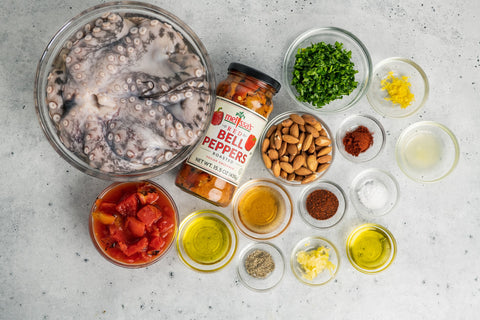
Ingredients
For the octopus:
2 ½ to 3-pound octopus, thawed, cleaned, ink sac and beak removed (ask the butcher to prepare this for you)
Olive oil
Salt and pepper
Garnish:
Italian Parsley
Fresh lemon
Instructions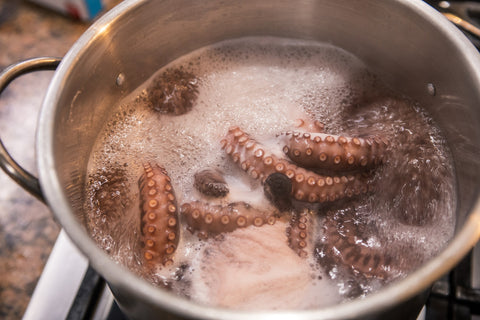
In a medium stockpot or Dutch oven, bring 2/3 pot water to a boil. If you have a thermometer, aim to keep the temperature at a steady 192 to 195 degrees Fahrenheit. This will be a slow simmer, with minimal movement of the water. Add the octopus to the pot and cook for about 25 minutes per pound. Slow cooking or poaching promotes tender versus tough or chewy meat. When a fork easily pierces the meat, it is tender and done. Drain the octopus and cool. At this point, you could actually eat it, but I’d like to show you how to grill it. By the way, after the octopus is poached, some of the tentacles may have a bit of a slimy feel. Some cooks like to remove this by gently rubbing it off with your fingers. However, when I read that Chef Eric Ripert of Le Bernadin likes the texture and flavor it adds, I left mine on too!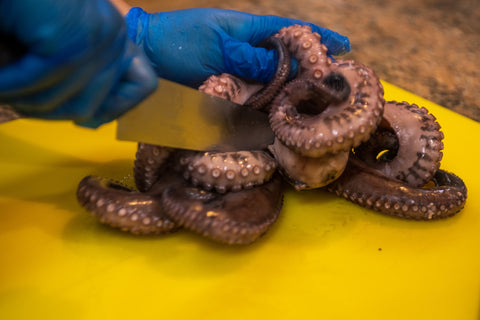
Before grilling, the head can be cut into slices or smaller pieces and the eight tentacles can be separated with a paring knife. Place the prepped octopus on a tray and lightly drizzle with olive oil and season with salt and pepper. 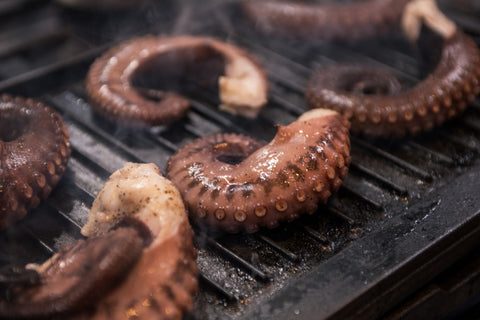
On a preheated medium hot grill, carefully grill the octopus for a few minutes on each side, just until it has a light char and is heated through. The meat can be plated as is, or cut in smaller pieces. Garnish with Italian parsley, lemon and serve with Sauce Romesco.
For the Romesco Sauce:
Yield: 2 cups
¾ cup fire-roasted tomatoes (half of a 14.5-ounce can)
2 garlic cloves, peeled
½ cup lightly toasted almonds
1 Melissa’s roast peeled red bell pepper (about 6 ounces)
1 tablespoon sherry or balsamic vinegar
1 tablespoon extra-virgin olive oil
1 teaspoon grated lemon peel
1/2 teaspoon piment d’Espellette or smoked paprika
½ teaspoon chile powder
½ teaspoon salt
½ teaspoon ground black pepper
Instructions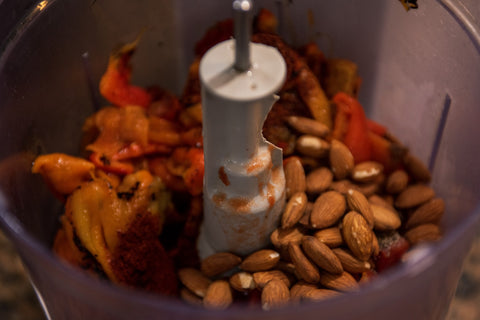
Place all ingredients in the bowl of a food processor or the jar of a blender. Pulse until everything is combined. The sauce will be slightly chunky. Taste and season more if needed. Keep refrigerated for up to a week.

